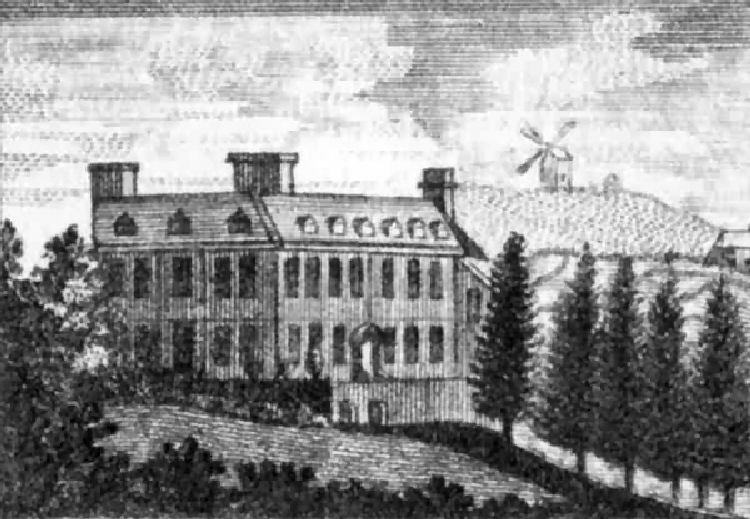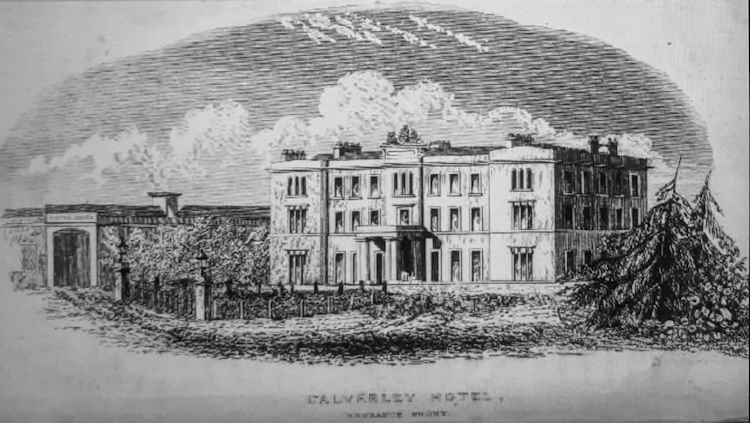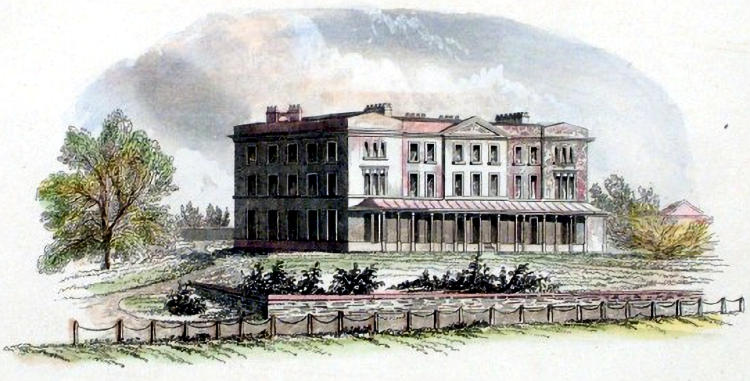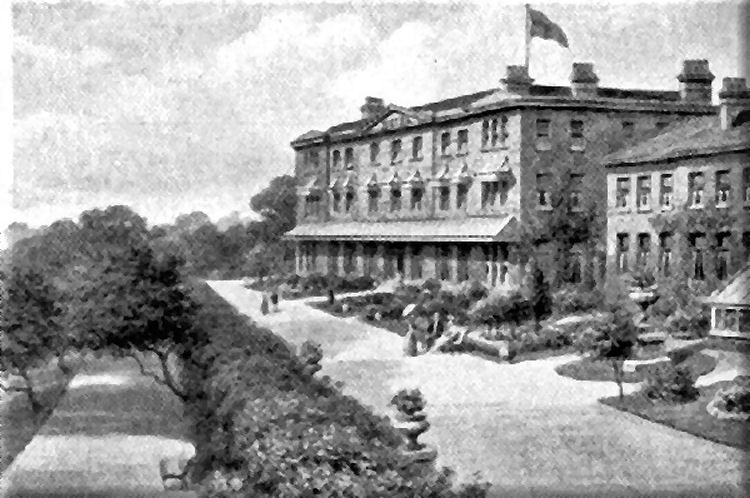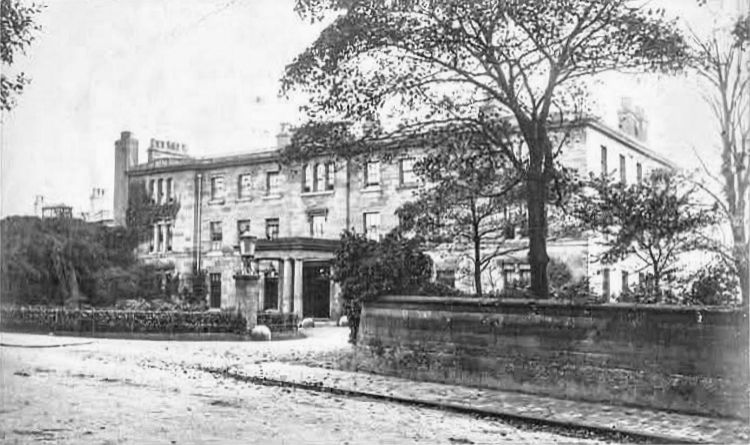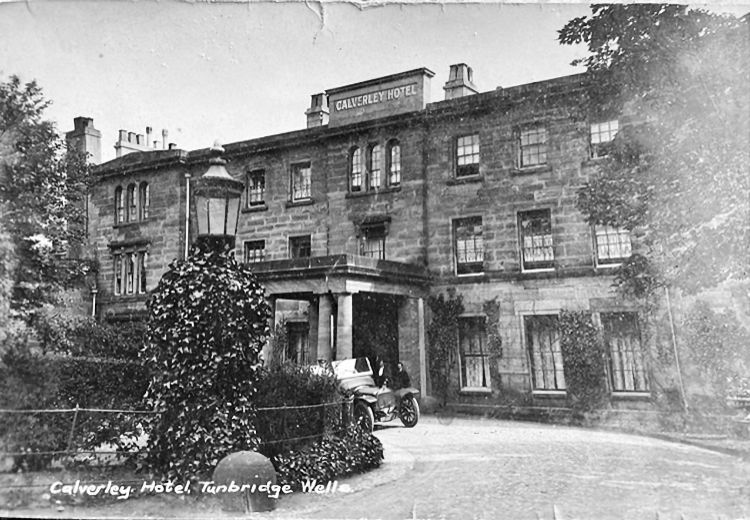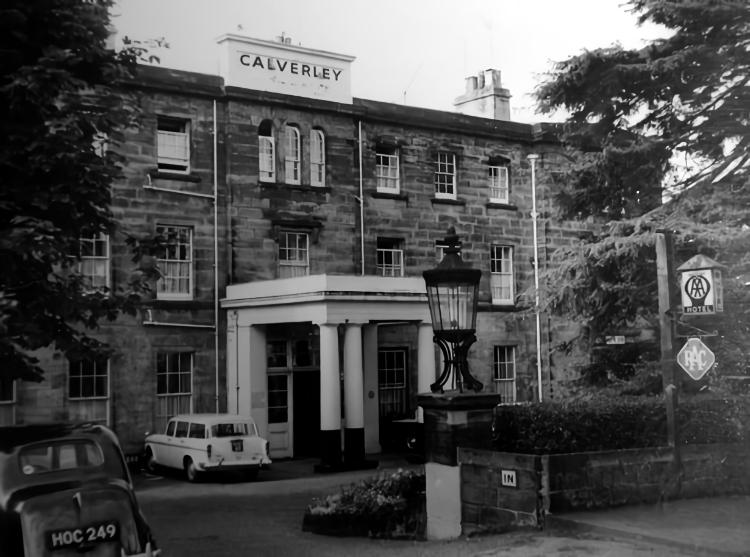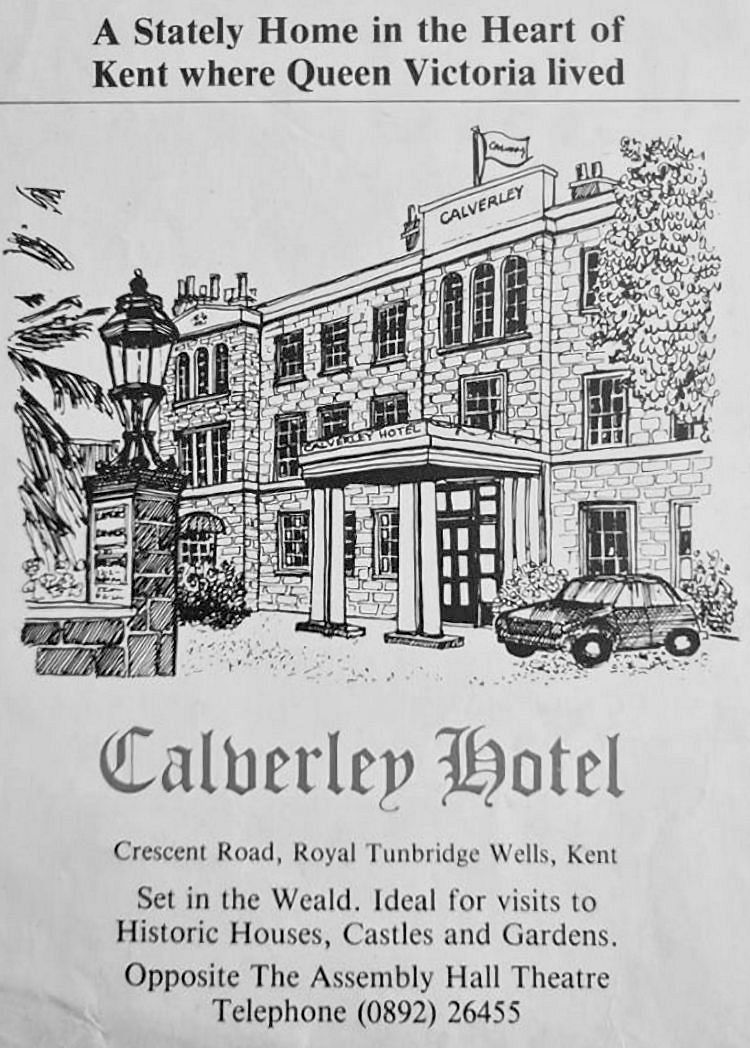|
Written By; Edward James Gilbert-Thunder Bay, Ontario,
Canada Date: 9 May, 2014
THE HISTORY OF THE CALVERLEY HOTEL
The "Calverley Hotel," now the "Hotel
du Vin," has a long and interesting history. It began as a large
private home constructed on the brow of a hill with large grounds at the
south east corner of Mount Pleasant Road and Crescent Road. Historical
accounts state that the home had been constructed in 1762 for the Earl
of Egmont, but this date must pertain to the rebuilding of the home. The
book' Royal Tunbridge Wells' by Roger Farthing provides on plate 36 a
view of the area and on the plate is marked “Esq. Strong” and a view of
Mount Pleasant House. This plate is from Kip's engravings of 1719. The
text associated with this image states “On the horizon Esq. Strong's,
the original Calverley Hotel building”. From the same book is plate 46,
showing Lord Percival and his wife with the text below stating “The
original "Calverley Hotel" house was almost certainly built by William
Strong (see plate 36) around 1700 and bought from his heirs by Lord
Percival, seen here with his wife. He became M. P. for Harwich in 1727
and was active in promoting the Georgia settlement. In 1734, as his
diary records on 26 March, he gave ‘Mount Pleasant at Tunbridge Wells'.
A house in London and the "George Inn," on Snow Hill in London, with a
total rental value of £319 a year, to his son to enable him to stand for
Parliament”.
In 1776 the Earl of Egmont, "having grown tired of the situation",
sold the house “at a considerable loss” to William Gratton, the
proprietor of the "Gloucester
Tavern" in the Pantiles, which was named after Queen Anne's son The
Duke of Gloucester, and which is referred to in accounts dating back to
at least 1706.
It is interesting to note the large house beside the name “ Mount
Pleasant”. Lord Percival made a comment from Farthing's book “ For 10
weeks each year from 1769 to 1789, when he died, the Duke of Leeds
rented Mount Pleasant House from William Gratton of the "Gloucester
Tavern" who had married the widow of an owner subsequent to Lord
Percival. The Duke is renowned for driving daily in his coach and six to
a point on the turnpike he called Turnham (Turn'em!) Green”.
In 1779 Thomas Osborn (1713-1789), the 4th Duke of Leeds, purchased
the home, who made improvements to it, and continued to live there until
his death in 1789. During this time the residence was referred to as
“Mount Pleasant House”, but during the latter part of the 18th century
and up to circa 1830 it became referred to as “Calverley House”. There
is also reference to the place sometimes being called “Lushington House”
prior to the redesign and enlargement of the building and its subsequent
conversion into a hotel. The reference to Lushington House is in
connection to Mr Lushington (1747-1823), a wealthy gentleman of
Eastbourne Sussex, who likely was the owner of the place at some point
in the buildings early history ,and who died in Tunbridge Wells in 1824.
After the death of Thomas Osborn in 1789 the home was occupied for
one season by the Duke of Chandos who died there in 1780. For many years
afterwards it was the residence of the venerable Dr Moss, the Bishop of
Bath and Wells, who died at age 92 sometime just before 1820. In 1795,
for a period of six weeks, the Royal Highness the Princess Sophia lived
there. In 1797 and afterwards other “Royals” lived there from time to
time.
Sir John Peachey, 3rd Baronet of Petworth (1720-1765) and his wife
Dame Elizabeth Peachey (1725-1804) lived there in the late 1700's and
Elizabeth Peachey “enlarged the house and remained there until her death
in 1804”.
By 1810 however, the home had become a Lodging House and therefore
had many distinguished occupants, like Dr Moss. In the period after 1810
it was also the occasional residence of Sir John Fagg, Bart of Mystole
House near Canterbury.
When Thomas Panuwell, Esq. died in 1823 his 1,000 acre Calverley
estate was purchased two or three years later by John Ward. Ward also
became the owner of Lushington House, which William Lushington had
bought in 1819 and who's park he had enlarged by the purchase of
adjoining fields.
In the period before 1830 the home had been altered many times. The
earliest descriptions of the building (1786) refer to it being
constructed of brick but later accounts describe it being of sandstone
(which it is today).
In the 1830's Calverley House was redesigned, altered, and refinished
by Decimus Burton, in conjunction with John Ward's residential
development of Calverley Park. The old part of the building was
incorporated into the new design and the rooms occupied by Royalty were
retained. The Duchess of Kent and Princess Victoria stayed there in 1827
and 1834 and Queen Victoria stayed at Calverley House in 1835. Roger
Farthing, in his book ‘Royal Tunbridge Wells” published in 1990 shows an
image of the building given as plate 89. The text with this image states
“Lord Percival's old Mount Pleasant House was bought by John Ward, the
Calverley developer, in 1825 but remained unaltered while required by
the Duchess of Kent. In 1837 however it was enlarged with two elegant
wings and an additional storey (to make 50 bedchambers and 14
sitting-rooms) and in 1839 it was leased to Edward Churchill, landlord
of the Kentish Royal”.
In 1839-1840 Calverley House became the Calverley Hotel and was run
by George Robinson.
By 1841 the hotel was being run by Edward Churchill under the name of
the Calverley Park Hotel. Edward Churchill was also associated with the
running of the Kentish Royal Hotel. Churchill was still at the Calverley
Park Hotel in 1862. During the time of Edward Churchill the 1859 the
Horticultural Fete was held in the grounds of the hotel.
Bracketts guide of 1866 refers to the hotel being able to accommodate
“no fewer than 13 families”, considerably less than the 35 rooms
available in 2014 at the hotel.
In the 1870's and 1880's the hotel was run by William
Pawley(1828-1908).
In 1891 the hotel was owned by Calverley Hotel Ltd and by 1918 was
referred to as the Calverley Hotel Co. Ltd.
In the period of 1922 to 1930 the Manageress of the hotel was Miss
Gladwin.
In 1961 the building was given a Grade II listing by English
Heritage.
This article provides a brief history of the Calverley Hotel covering
the period of 1762 until 1930 with some reference to its current use as
the "Hotel
du Vin." I begin my account with the following section quoted
directly from the source.
An image of Mount Pleasant House dated 1797 can be viewed from The
Weald website. Note the windmill shown in the background and note how
different the building looks to other images of the building given later
in this article. Tunbridge Wells and its neighbourhood 1810 By Paul
Amsinck.
The text below is from the 1810 account by Paul Amsinck.
“Mount Pleasant which next attracts our notice, contained originally
but one house. About thirty years since, an indifferent lodging house
was enlarged, and the adjacent grounds extended and embellished, by
Elizabeth, the widow of Sir John Peachey, Bart, the elder brother of the
first Lord Selsea. She made it one of the most desirable residences, at
Tunbridge Wells; and occupied it, in the exercise of an extensive
benevolence and liberal hospitality, till her death. It has since become
the property, and is the occasional residence of Sir John Fagg, Bart, of
Mystole House, near Canterbury. Still the great Mount Pleasant House
retains its exclusive claim to that appropriate designation. It is now
only a lodging house, let as one, or divisible into two, as the
circumstances of the tenants may require. Many persons of distinction
have wished to become the purchasers of it; captivated by the beauty of
the situation, and the capability of improvement in the adjacent
grounds; but having descended to the present proprietor as heir at law,
on the last possessor having informally bequeathed it to a roman
catholic establishment, some doubts, as to the validity of the title
have been raised, which have hitherto proved obstacles to the transfer
of the property”.
“This place has heretofore been the occasional residence of many
distinguished persons. It was formerly a seat of the Earl of Egmont. For
twenty successive seasons it was the constant abode, for the precisely
measured period of ten weeks, to Thomas, the fourth Duke of Leeds: which
he continued till his death in 1789. [The subjoined early testimony to
the character of this truly respectable nobleman, occurs in a letter
from Lord Oxford to Dr. Swift, bearing the date of June 19, 1735." The
Duke of Leeds is returned from his travels a fine gentleman; and has
imported none of the fopperies and fooleries of the countries he has
passed through."]
“This noble personage formed so conspicuous a feature in the costume
of Tunbridge Wells, that it will be allowable to pause a little on his
name and character. The ancient system of the place prevailed during his
abode in it: and he was invariably seen on the parade at the usual hours
of assembling there. He may be said to have precisely exemplified Mr.
Burke's happy and elegant definition of a nobility, "the Corinthian
capital of polished society" Dignified in his manners, polite in his
demeanour, affable with all, and actively benevolent; he so apportioned
his attentions, and so encouragingly displayed his goodwill to all, that
he became the most popular character in the place; and his implied wish
on any subject was equivalent to a law. Although he divested himself of
the aristocratic air in his conversation and countenance, never did he
so in his equipage and exterior. His star invariably decorated his
person, even on his great coat; and his full equipage regularly conveyed
him to the Wells, and for his airing. After the morning bustle of the
day, his habits were retired. He had usually his small party at dinner;
and at the appointed hour, or rather minute, the coach and six was at
the door for the evening excursion towards a spot on the London road,
which his Grace denominated Turnham Green, from an open space, which
admitted of the turning of his cumbrous equipage.”
“On one single day in the year he would make his evening appearance
in the Rooms: this was on the birth-day of the Prince of Wales. On this
occasion it had been his custom to give a public tea-drinking and ball
to the company; and, if the state of the weather permitted, the former
part of the entertainment took place on the Parade; at that time
denominated the Pantiles. The tables were spread, according to the
numbers to be accommodated, down the walks; and it may be noticed, as a
singular contrast to the unmannerly intrusion of the present times,
that, although the novelty of such a scene might be supposed to yield
attractions, and almost to justify some deviations from a rigid
propriety, there never was any advance on the part of the lower classes
to disturb the comfort of the meeting. But not only the days of
chivalry, but even those of decency and good order are gone by”.
“After the death of the Duke of Leeds, for one season, the Duke of
Chandos made this house his residence; and died there, honoured and
lamented by all who knew him. For many years it was, in the early part
of the season, the residence of the venerable Dr. Moss, Bishop of Bath
and Wells; who for more than half a century had been a regular
frequenter of the Wells : and died not many years since, in the full
enjoyment of his faculties, at the great age of ninety-two.”
“In the year 1795, her Royal Highness the Princess Sophia, having
been recommended to drink the Tunbridge waters, resided for that
purpose, about six weeks, in Great Mount Pleasant. On her arrival, she
was in a most debilitated state of health: during her residence, she
rapidly amended, and quitted the place completely restored. Two years
after the same house was destined to receive royal guests, of a
different description, and under different circumstances: - the Prince
and Princess, with the hereditary Princess of Orange. The Duchess of
York accompanied them; and the excursion was understood to have been
chiefly undertaken on her Royal Highnesses account. This visit took
place in the early stage of those revolutionary scenes, which have since
proved so fatal and humiliating to crowned heads; but so frequent, as
almost to cease exciting wonder. The near alliance of the parties to our
own reigning family, and their steady adherence to the interests of this
country, occasioned these royal exiles to participate largely in the
compassion of Britons: and during their residence among them, the
inhabitants of the Wells readily united with their fellow citizens in
yielding them the tribute of their utmost benevolence.”
THE HISTORY OF THE HOUSE UP TO 1840
The location of the large building on the left of the hotel with a
sign over the entrance “Hotel Mews” which at that time would have been
used to house horses and carriages.
Mount Pleasant House was built in 1762 for the Earl of Egmont. The
residence was described in 1776 as “a noble modern brick house, built in
a genteel taste, upon the brow of a delightful hill which commands an
extensive prospect of the place. This was lately the property of the
right honourable the Earl of Egmont, but is now presently that of Mr
William Gratton, master of the Gloucester Tavern”. From Tunbridge Wells
Past and Present by Strange (1946) “The Earl of Egmont built Mount
Pleasant House. Afterwards it was much improved by the Duke of Leeds,
who purchased it in 1779. Subsequently it was called Calverley House
which now forms the older part of the Calverley Hotel”.
The Earl of Egmont was descended from the Flemish noble family of
Philip van Egmont of The House of Egmont in the Netherlands. British
Parliament records of 1789 refers to the Duke of Edgmont and to Lord
Lovell, the Earl of Egmont and apart from his other activities he was
obviously a wealthy man and a member of the British Parliament.
In 1776 the Earl of Egmont, "having grown tired of the situation",
sold the house “at a considerable loss” to William Gratton, the
proprietor of the Gloucester Tavern in the Pantiles ,which was named
after Queen Anne's son The Duke of Gloucester, and which is referred to
in accounts dating back to at least 1706.An advertisement announced “The
"Gloucester Tavern,"
Tunbridge Wells, is open for the season. The bedding is well aired and
properly attended. Your very obliging and humble servant William Gratton”.
Another account states that the "Gloucester
Tavern" was named after the Duke of Gloucester who was in Tunbridge
Wells in 1698 and who played with other children on the Upper Walk of
the Pantiles. John Byron, the writer, was in Tunbridge Wells August 1723
and said in his accounts “ We walked upon the Walks, a great deal of
company here; we had supper at the "Gloucester
Tavern"”.
An 1808 map by T. T. Barrow showed the location of an listed the
lodging houses in the town. On that map is given, in the location of
what would become the Calverley Hotel, a building labelled as “Great
Mount Pleasant”. In addition to the map Barrow produced a covering page
to the map on which is shown an image of a large house labelled as
“Mount Pleasant House”.
The 1912 publication by Lewis Melville entitled Society in Tunbridge
Wells in the 18th Century' gave “ On Mount Pleasant stands a very noble
house which is let out by the season by Mr Gratton, the master of the "Gloucester
Tavern." It is the best lodging house thereabouts, and was built by
Lord Egmont, who, growing tired of the situation sold it at a
considerable loss”. Another source gives “ Several good taverns supplied
wine, including by 1706 the "Gloucester Tavern," named after Queen
Anne's son the Duke of Gloucester”.
Peltons 1829 Guide gives the following “ Adjacent to the Calverley
Promenade is the Calverley Hotel, which has recently been finished
(redone by Decimus Burton), the accommodation here being first-rate with
the situation in which it is placed, commanding as it does an
uninterrupted view over delightful scenes, renders it one of the most
charming spots in the country”. Accounts indicate that although
Calverley House was extensively redone by Burton in 1829 it did not
become a hotel until 1840 when it was rebuilt. However a map of 1839
labels the building as a hotel. The Descriptive Sketches of Tunbridge
Wells by Britton in 1832 gives Information on the hotels in the town at
that time but no mention is made of the existence then of the Calverley
Hotel.
There is reference in 1835 to the mother of Queen Victoria staying at
Calverley House “which was formerly Mount Pleasant House”.
Peltons Guide of 1876 by John Radford Thompson states in part “Prior
to the erection of the hotel, this site was occupied by Lushington
House, a favourite summer residence of the late Dutchess of Kent and her
daughter, then Princess Victoria, and now the Queen of England”. Peltons
1840 Guide gave in part “The Calverley House was sometimes called
Lushington House, which was altered many times before Burton (1800-1881)
incorporated it into the Calverley Hotel”…. It was built as a private
residence in 1762-the owners delaying its conversion to a hotel because
of Queen Victoria's last visit in 1835”.
Bracketts Guide of 1866 gave in part “ Prior to its conversion into a
hotel it was known as Lushington House and for several seasons was a
favourite residence of the Queen and Princess Victoria and the late
Duchess of Kent stayed there in the summer.
So where did the name “Luchington House” come from? The answer (from
The Annual Biography of 1824) is that it is named after William
Lushington (1747-1823) who was from Eastbourn, Sussex but died in
Tunbridge Wells September 11,1823. The source says “He was formerly a
merchant in London and an agent for the Isle of Grenada. He was elected
MP for the City of London in 1795 on the death of Mr Alderman Sawbridge,
and in the same year was elected Alderman of Billingsgate Ward, on the
death of Mr Alderman Sainsbury. He resigned his Alderman's gown in 1799,
and retired from the representation of the City of London, at the
general meeting of 1802. He also filled the office of Vice-President of
the Artillery Company; Treasurer of the City of London Lying-in-Hospital
in the City Road and Vice President of the Society of Patrons of the
Charity Schools, of the Asylum for the Deaf and Dumb, and of the
Universal Medical Institution in Old Gravel Lane. He was also a Director
of the British Fire office. Mr Lushington was a man of great ability,
and a eloquent speaker, both in parliament and in the city senate. He
published ‘The Interests of Agriculture and Commerce inseparable' 8
volumes in 1808.”
William Lushington had been born January 18,1747 at Markshall, Essex
and was one of eight children born to Henry Lushington (died 1799) and
Mary Asthem (died 1775). He had married Pauline French (died 1897) March
28, 1769 and with her had two sons and two daughters. A review of his
will, which was probated October 13,1824, shows he was from Tunbridge
Wells and that he left his entire estate to his daughter Charlotte
Lushington. A burial register records him born 1747, died 1823 and
buried September 19, 1823, age 76 at Lewisham St Mary, Kent.
Another reference to William Lushingtron is in the book ‘Royal
Tunbridge Wells' by Roger Farthing, published 1990 in which the
following is given “On 30 December 1823 Thomas Panuwell Esquire died and
in the next two or three years John Ward acquired Panuwell's 1,000 acre
Calverley estate: the future Calverley Hotel which William Lushington
had bought in 1819 and whose park he had enlarged by the purchase of
adjoining fields……….”….. "The Princess Victoria and her mother, the
Duchess of Kent, came an stayed in Calverley House in 1826, 1827, 1828
and 1834…” In reference to the arrival of the railway in the town on
September 19,1845 Farthing states “On June 23, 1849 the Queen and Prince
Albert tested the route on an apparently unpremeditated visit to the
Queen Dowager at the Calverley Hotel”. Shown opposite is an early image
of the Calverley Hotel from Farthings book with the following caption
“Lord Percival's old Mount Pleasant House was bought by John Ward, the
Calverley developer, in 1825 but remained unaltered while required by
the Duchess of Kent. In 1837 however, it was enlarged with ‘two elegant
wings' and an additional storey (to make 50 bedchambers and 14
sitting-rooms) and in 1839 it was leased to Edward Churchill, landlord
of the Kentish Royal”.
In 1779 Thomas Osborn (1713-1789), the 4th Duke of Leeds ,purchased
the home, who made improvements to it, and continued to live there until
his death in 1789. During this time the residence was referred to as
“Mount Pleasant House”.
Thomas Osborn had been born November 6, 1713 and died March 23, 1789.
He was styled the Earl of Danby from birth until 1729 and subsequently
Marquess of Carmarthen until 1731 and was a British peer, politician and
judge. He was the older and only surviving son of Peregrine Osborne, 3rd
Duke of Leeds and his first wife Elizabeth, youngest daughter of Robert
Harley, 1st Earl of Oxford and Earl Mortimer. Osborne was educated at
Westminster School and then Christ Church College, Oxford, where he
matriculated in 1731.In the same year, he succeeded his father as duke.
Osborne received a Doctorate of Civil Law in 1738 and became a Fellow of
the Royal Society a year later.
Osborne became a Lord of the Bedchamber in 1748 and was appointed
Justice in Eyre south of Trent in November of the same year. In June
1749, he was made a Knight of the Order of the Garter and in 1756,
resigning from his post as justice, was nominated Cofferer of the
Household. He was sworn of the Privy Council of Great Britain a year
later and became Justice in Eyre north of Trent in 1761, an office he
held until 1774.Osborne was a Deputy Lieutenant of the West Riding of
the County of Yorkshire. In 1766 he inherited the office of Governor of
Scilly and the lease of these islands from his father-in-law.
On 26 June 1740, he married Lady Mary Godolphin, second daughter of
Francis Godolphin, 2nd Earl of Godolphin and his wife Henrietta
Godolphin (née Churchill), 2nd Duchess of Marlborough, and had by her
three sons and a daughter. Osborne died, aged 73 at St James's Square
and was buried at Harthill, South Yorkshire. He was succeeded in his
titles by his third and only surviving son Francis(1751-1799).
The Tunbridge Wells Guide by Jasper Strange 1817 gives the following
“Mount Pleasant gives site to a noble modern brick house, built in a
genteel taste, upon the brow of this delightful hill, which commands an
extensive prospect of the place. The situation of this house in
extremely happy, the grounds and gardens belonging to it are well
disposed, and justly deserve the name it has acquired. His Grace the
Duke of Leeds, honoured it with is presence for several seasons, and
during that time, frequented the Walks, and mixed with the company with
such affability and condescension as not only to engage the respect due
to his high rank, but that universal esteem which greatness alone cannot
command.” This account goes on to refer to a compliment made to him by
“the late very ingenious Mr George Lewis, Vicar of Westerham that was
addressed to His Grace on his annual ball on the Prince of Wales
birthday in 1770. The Duke of Leeds is in some accounts referred to as a
“summer visitor” and so it appears the home was vacant the rest of the
year of perhaps leased out by him when he was away. The Descriptive
Sketches of Tunbridge Wells and Calverley buy John Britton in 1832
refers to the Duke of Leeds as a “distinguished character who lived in
Tunbridge Wells”. The Tunbridge Wells Guide by Jasper Strange in 1786
gave the same account as that of 1817.
After the death of Thomas Osborn in 1789 the home was occupied for
one season by the Duke of Chandos who died there in 1780. For many years
afterwards it was the residence of the venerable Dr Moss, the Bishop of
Bath and Wells, who died at age 92 sometime just before 1820.In 1795,
for a period of six weeks, the Royal Highness the Princess Sophia lived
there. In 1797 and afterwards other “Royals” lived there from time to
time.
Sir John Peachey, 3rd Baronet of Petworth (1720-1765) and his wife
Dame Elizabeth Peachey (1725-1804) lived there in the late 1700's and
Elizabeth Peachey “enlarged the house and remained there until her death
in 1804”. Sir John Peachey was the elder brother of the 1st Lord Selsea.
The publication ‘The House of Commons 1754-1790' gave the following
information about Sir John Peachey. “Sir John Peachey, 3rd Baron
(1720-1765) , of West Dean, Sussex. Midhurst April 23,1744-1761. Born
1720, the 1st son of Sir John Peachey, and Bt., M.P., of West Dean, and
brother of James Peachey. Educated; Westminster June 1729; ch.ch. Oxford
November 17, 1737, aged 17. Married August 18,1752 Elizabeth, daughter
and heir of John Meeres Fagg of Glynley, Sussex, succeeded father as 3rd
Baron April 12,1744.The Peachey family had considerable interest at
Midhurst in the 1st half of the 18th century. Sir John Peachey was a
follower of the Price of Wales and also went over to the Pelhams in
1751, and subsequently became an adherent of Newcastle. In 1760 he sold
his property at Midhurst, and at the general election of 1761 withdrew
from politics. He died June 30, 1765 and was succeeded by his brother
James Peachey in July 3, 1765.” In researching his wife Elizabeth I
found “After the death of Lady Elizabeth Peachey her mansion called
‘Glenleigh' in Westham, Sussex became the property of R. Hawes, esq.,
and then to the Fagge family”. I also determined that Dame Elizabeth
Peachey, born 1725 died at the age of 79 in 1804 and upon her death
Calverley House changed occupants once again.
From my overview at the beginning of this article I wrote “By 1810
however, the home had become a Lodging House and therefore had many
distinguished occupants, like Dr Moss. In the period after 1810 it was
also the occasional residence of Sir John Fagg, Bart of Mystole House
near Canterbury.
In the period before 1830 the home had been altered many times. The
earliest descriptions of the building (1786) refer to it being
constructed of brick but later accounts describe it being of sandstone
(which it is today).
In the 1830's Calverley House was redesigned, altered, and refinished
by Decimus Burton, in conjunction with John Ward's residential
development of Calverley Park. The old part of the building was
incorporated into the new design and the rooms occupied by Royalty were
retained. The Dutchess of Kent and Princess Victoria stayed there in 1827
and 1834 and Queen Victoria stayed at Calverley House in 1835.
The 1840 Pigots directory gave the following listing “Calverley Hotel,
George Robinson (The Hotel Keeper). Under the heading of Estate Agents
was the 1840 Pigots listing “George Robinson, 6 Calverley Promenade
(Wards Calverley Estate Agent). The same directory gave Edward Churchill,
who would later take over the hotel, as being at the Kentish Royal
Hotel. George Robinson is found in the 1841 census at 6 Calverley
Promenade and working as an estate agent for the Calverley Estate.
George was born 1791 in Kent and in the 1841 census his wife Cornelia,
age 40, and his daughter Eliza, age 15 were living with him. George and
his family were still at 6 Calverley Promenade at the time of the 1851
census but was gone by 1855. What became of him is not known by the
researcher.
The 1841 census, taken at the Calverley Park Hotel listed Edward
Churchill, age 40, born 1801 at the hotel keeper. Living with him was
his wife Elizabeth, age 35, born 1806. In addition there were over 60
guests and servants at the hotel. Edward Churchill took over the running
of the Royal Kentish Hotel in 1831. Edward Strange had run that hotel
until his death in 1823 and then his wife continued for another eight
years until 1831 at which time Edward Churchill took over. As can be
seen by reviewing directory listings Edward Churchill is found
throughout the period of 1841 to 1851 as the proprietor of both the
Calverley Hotel and the Kentish Hotel yet he is found in the census
records for the same period always as the proprietor of the Calverley
Hotel. One can only conclude that he ran both hotels during that period.
Mr Churchill was a well-known figure in the town. Edward Churchill
spent his life working in the hotel industry. There is an advertisment for the hotel during the time of
Churchill, dated 1846. The advertisment reads "Churchill Royal Kentish
Hotel (fronting the Common), Tunbridge Wells. It is within a minute's walk
of the celebrated springs. The comforts of this house are well known and
appreciated. Omnibus from this hotel meet every train”. It would appear
that Mr Churchill was running two hotels up to 1852 for directories of
1847, 1851 1858 and 1862 all list him as the proprietor of the Calverley
Hotel. It is known that William Haines replaced him at the Kentish Hotel
by 1852.
Edward Churchill was born September 12, 1796 in London to William and
Frances Churchill and later moved to Banbury, Oxfordshire. In the 1820's
he moved to Tunbridge Wells and went into business. He is found in the
local directories as the proprietor of the Market House from 1832 to
1834,and establishment previously run by Edward Hilder Strange as early
as 1814 and up to his death in 1823.Edward Churchill was also the
proprietor of the Corn Market House on London Road in the period of
1839-1840 and from 1841 to 1869 the proprietor of the Calverley Hotel.
Edward's marriage on April 26,1832 to Elizabeth Beane, the eldest
daughter of Joshua and Catherine Bean of Banbury, at St Mary's
church, records that Edward is an innkeeper of the Royal Kentish Hotel. A
directory for 1840 under the heading of 'Undertakers' lists Edward
Churchill of the Royal Kentish Hotel. In the same directory under Tavern
and Public Houses is "Edward Churchill, London Road (Corn Market House).
Edward Churchill was a busy and enterprising man for in the 1851 census
he is found residing at the Calverley Hotel as its proprietor along with
his wife, twenty hotel guests and a large number of servants.
In the 1861 census Edward Churchill is found living at the Fernclyffe
mansion on Pembury Road, with his wife; his sister-in-law; a
visitor and three servants. Edward's occupation is given as "merchant and
hotel keeper". The hotel referred to is the Calverley. The 1862 Kelly
directory gave the listing “ Edward Churchill, Calverley Hotel & corn
dealer, London Road and Calverley Park”.
Edward and Elizabeth had at least one son namely Reverend Edward Beane
Churchill who died November 28,1901 at the age of 58 at Manor
house, Ashmansworth, Hants. Edward's wife died in Tunbridge Wells sometime
between 1862 and 1869.On April 21,1869 Edward Churchill passed away at
Fernclyffe leaving an estate of under 25,000 pounds to his son Reverend
E.B. Churchill of Portsea, Southampton.
Peltons 1876 guide states in part “The Calverley Hotel is built of
sandstone, after the design of Mr Decimus Burton, and occupies a
commanding position near the entrance to Calverley Park. The Calverley
is exclusively a family hotel of the highest order, and provides
accommodation for many families. The grounds which cover several acres,
are tastefully laid out, and the terraces command extensive views
southward.” This guide has a sketch of the hotel on page 44. Burton
added one of the most attractive features of the hotels exterior, namely
the veranda on the south side overlooking Calverley Park. This veranda
can be seen in some of the images of the hotel I have provided.
The 1874 Post Office directory listed William Pawley as the keeper of
the Calverley Hotel. He was still in charge at the time of the 1881
census. In the 1881 census he is given as age 49, born in Bromley, Kent.
Living with him was his wife Annie, age 25, born in Cornwell, USA and
their five year old daughter Ethel. Also staying at the hotel were 17
guests, and 12 members of staff. William Pawley was still in charge of
the hotel at the time of the 1882 census.
In 1891 the hotel was owned by Calverley Hotel Ltd and by 1918 was
referred to as the Calverley Hotel Co. Ltd. In the period of 1922 to
1930 the Manageress of the hotel was Miss Gladwin.
THE CALVERLEY PARK DEVELOPMENT
The 1907 OS map of the area indicating the location of
the Calverley Park Hotel and Calverley Park. Most of the original extensive grounds of the hotel had been absorbed
into Calverley Park. The original grounds of the residence were in the
order of 22 acres but by 1907 consisted of no more than about five acres
in a narrow strip extending from the eastern edge of the hotel westward
to the corner of Mount Pleasant Road.
A map dated 1831 from a booklet entitled ‘Tunbridge
Wells 1951' which shows the Calverley Park development and “Calverley
House”, both shown and labelled on the map. The booklet also gave the
following “The oldest building, Calverley House, was, it is true,
erected in 1762 by the Earl of Egmont under the name of “Mount Pleasant
House”, and enlarged later by the Duke of Leeds. Matthew Calverley
himself altered the name to Calverley House, and in 1840 it was further
enlarged and opened as a hotel. The house was the residence of the
Duchess of Kent and her daughter (later Queen Victoria) in 1827 and
1834”…Matthew Calverley himself appears to have had far less to do with
the fantastic development of his land than John Ward, who owned it after
him, and Decimus Burton, the famous architect. But it is Calverley's name
that appears on all the signposts. Mathew Calverley was an obscure
gentleman, for whom little is known, but he owned this large amount of
undeveloped property at the beginning of the 19th century”.
Calverley Grounds were originally the private gardens of the Calverley
Hotel, part of the Calverley Park development of 1825, for which Decimus
Burton (1800-81) was the architect and planner. His inspired use of the
sloping site created a romantic parkland with views over the distant
countryside.
Calverley Park and Grounds and adjoining property which together formed
the Calverley estate was acquired in 1820 by John Ward. Development of
the villas and their associated landscape setting, to designs by Decimus
Burton, began in the autumn of 1828 (Colbran 1840) and was complete by
1839. The Ward Estate remained the freeholder, the villas being occupied
leasehold until they were progressively sold off from 1947 and the
parkland became the property of the trustees of the Calverley Park
Association. In November 1920, the western half of the site, known as
Calverley Grounds, was acquired by Tunbridge Wells Borough Council for a
public park. The site remains (1999) in the hands of the individual
villa owners who form the Calverley Park Association, the local
authority, and a number of further individual and commercial private
owners.
THE HORTICULTURAL FETE OF 1859
On July 1,1859 the Tunbridge Wells Horticultural Fete was held, a
complete account of which I have given here. Although no mention is given
in the account about the TWHS organizing the event I believe it is safe
to assume that they were the organizers. The account is as follows " A
grand horticultural fete was held at Tunbridge Wells, in the grounds
adjoining the Calverley Hotel, on Friday July 1,1859 which was honoured
by the presence of the Countess de Neuilly, the Duke de Nemours,the Count
d'Eu, and suite. They were conducted from the Calverley Hotel, at which
they have been staying for some days, by the Hon F.G.Molyneux and other
members of the committee and, on their arrival at the entrance to the
grounds, the Countess, and each of the ladies of her suite, was presented
with an elegant bouguet by Mrs. George Goldney, the wife of the Rev. G.
Goldney, one of the members of the committee. We will follow the noble
party in their tour through the tents."
"The first entered was that devoted to the productions of cottager's
gardens, where the fruits and vegetables exhibited by W. Brown, of
Southborough, attracted much notice. The next tend was filled with cut
flowers. Here the collection of roses shown by Mr Hollamby, of the
Strawberry Hill Nursery,
near Tunbridge Wells, was most splendid; nor should we omit to notice
that of Mr Mitchell, of Tower Nursery, near Heathfield, or a box of cut
verbenas exhibited by Mr Foreman, gardener to the Rev. G. Goldney, which
was deservedly commended. Among the fruit (which, howrever, was decidedly
poor considering the liberal prizes offered) were some very fine
grapes,grown by Mr Powell,gardener to Dr S. Newington,and a fair
collection of six dishes of fruit from Eridge Castle, exhibited by Mr
Ogle, gardener to the Earl of Abergavenny. The collection of stove and
greenhouse plants in this tend contained some very fine ericas, shown by
Mr Gilbert, gardener to E.L.Mackmurdo, Esq., of Hastings, and some gloxineas
from the gardener of H. Reed, Esq.,of extraordinary growth, also a fine
collection of British and exotic ferns, grown by Mr Maxted, gardener to J,
Field, Esq. Beyond this were some splendid plants, exhibited by Mr
Gilbert, which obtained first prize, among which were conspicuous
Aphelexis sesamoides Basrnsii, Rhyncospermum jasminoides, and Alamanda
cathartica. Mr Ping, gardener to Henry Reed, Esq.(of Dunorlan), had many
fine plants; two noble vincas, the rare and beautiful plant Cyanophyllum
magnificum, Cissus discolor in general beauty, an immense plant of Coleus
Blumei, Caladium bicolor, and C. distillatoria with leaves of enormous
size, and a very fine Araucaria escelsea. Messrs. Rycroft and
Wells, gardeners to Alderman Salomons (of Broomhill),M.P. ,had a
Medinella magnifica which eminently deserved its name; five or six
achimenes highly commended by the judges,and many other well-grown
plants;and Mr Drummond,gardener to J, Scott Smith,Esc.,Phoenicoma
prolifera Barns-,a very well-flowered Statice Holfordii, and Roella
Ciliatra. The pelargoniums, though past their best, were very beautiful, Mr
Gilbert obtaining the first prize for six shows, and Mr Pring for six
fancy varieties. The band of the royal Artillery, consisting of fifty
performers, under the able superintendence of Mr Smith, was in
attendance, and played some beautiful pieces. There could not have been
less than five thousand visitors in the grounds during the day."
The above article was published in the Illustrated Garden News on July
9, 1859 and remarkably included with the article was a wood engraving, which I have shown here, of the event. The original engraving
measuring 5.75" by 9.5" was made by an unknown artist from a sketch made
at the time of the event only 8 days before the image appeared in the
publication. Although originally published in black and white the image
was later hand coloured.
The Rev G. Goldney referred to at the Fete was Rev George Goldney, M.A. a
clergyman born 1816 at Buckingham, Buckinghamshire whose wife was Ann
Goldney, born 1826 at Great Marlow, Buckinghamshire.
The F.G Molyneux referred to at the Fete was the Honourable Francis
George Molyneux, born March 5,1805 at St George Hanover, London who died
in Tunbridge Wells May 24,1886. His wife, whom he married in 1842 was
Georgiana Jemima Ashburham, born May 11,1805 at St George Hanover, London
who died in Tunbridge Wells on May 1882. Francis Molyneux was a well-
known figure in the town. He was a leading citizen and town benefactor
who had arrived with his wife in Tunbridge Wells in 1853.He first lived
at Gibraltar Cottage but subsequently built a mansion at 76 Mount
Ephraim called Earl's Court which later was converted into a hotel, then
offices and now is luxury apartments. He was a British diplomat who was
appointed secretary to His Majesty's Legation at Frankfort Germany
October 28,1835..He was a a J.P. and magistrate for Kent and a leading
member of the Freeholders, as well as the Local Board, the towns first
local government. In 1871 he inaugurated the granite fountain that now
stands in the Woodbury Park Cemetery that was originally installed in
town until proposed roadwork necessitated its relocation. Francis, at the
ceremony even quenched his thirst by taking a sip of water from the
fountains iron cup.
ENGLISH HERITAGE LISTING
English Heritage gave the Calverley Hotel a Grade II listing on November
24,1966. Given below is a description of the listing.
“CRESCENT ROAD 1. 1746 (South Side) The Calverley Hotel TQ 5839 SE 7/79
24.11.66. II 2. This was built as Calverley House in 1820 and enlarged
by Decimus Burton in 1840 when it became a hotel. Built of Tunbridge
Wells stone. 3 storeys. Parapet and cornice. Sashes with most glazing
bars intact. 9 windows windows. The end window bays and the centre one
projects with small pediments over. Hoods to some 1st floor windows.
French windows on the ground floor which has now lost its hooded
veranda. Large stuccoed Tuscan porch on the street front. The Duchess
of Kent and Princess Victoria stayed here when the house was Calverley
House in 1827 and 1834.”
THE HOTEL du VIN
Today the former Calverly Hotel is the Hotel du Vin which has 36 rooms,
a billiard room, a boules court, although in 2000 it was reported to have
32 rooms. It also has a fine restaurant and although some guests say the
rooms are small they all give good reports about their stay at the
hotel. The rooms in the hotel are all named after various drinks.
|
